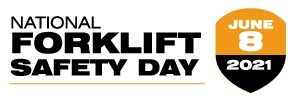National Forklift Safety Day 2021 puts safety in context
Speakers addressed OSHA priorities, supply chain pressures on retail, and operator training.

The Industrial Truck Association (ITA) sponsored the eighth annual National Forklift Safety Day on June 8, 2021, an event designed to educate customers, government officials, and other stakeholders about the safe use of forklifts and the importance of training operators and pedestrians who work around forklifts. Typically held in Washington, D.C., with an educational program, regulatory updates, and meetings with members of Congress, this year’s event was limited to the educational segment and was presented as a webcast. Highlights include:
ITA President Brian Feehan and Jay Gusler, ITA Chairman and Executive Vice President of Operations, Mitsubishi Logisnext Americas, opened with remarks on the industry’s ongoing commitment to forklift safety. Gusler noted that the pandemic-created surge in e-commerce demand is a factor in the current “very robust” lift truck market. With many more forklifts in operation during the pandemic, he said, companies have had to innovate safety protocols while maintaining existing standards.
James Frederick, Deputy Assistant Secretary of Labor, Occupational Safety and Health Administration (OSHA), said that in FY 2019 (the most recent complete statistics) there were 79 forklift-related fatalities and 8,140 serious injuries. Since FY 2011, forklift-related fatalities increased by 19.7% and serious injuries increased by 32.8%. Temporary employees and those with a year or less in their current jobs are particularly at risk, he said, adding that four of the top five forklift-related violations cited in 2019 involved operator training.
Under the Biden Administration, Frederick said, OSHA will be “reinvigorated,” and the agency will enhance support for “often forgotten” frontline, vulnerable workers and small employers in essential industries. OSHA will also work to eliminate inequalities in workplace health and safety, and to ensure equal protection for all stakeholders. This initiative reflects a Biden Administration directive that federal agencies assess whether workers face systemic barriers to accessing programs benefits and opportunities. In fact, Frederick said, some workers do not receive the same level of safety training as other employees because of language differences, race, ethnicity, immigration status, or other factors.
Tony Sciarotta, Executive Director and Publisher, Reverse Logistics Association (RLA), and Jess Dankert, Vice President for Supply Chain, Retail Industry Leaders Association (RILA), discussed some of the challenges their industries—which heavily rely on warehouses, distribution centers, and fulfillment centers—are currently confronting.
Sciarotta focused on e-commerce business models and the consumer behavior behind product return rates of 8% to 25%, depending on the type of product. He emphasized the need for retailers and their service providers to provide a positive consumer experience supported by seamless, efficient, end-to-end logistics solutions. With the total cost of handling returns reaching as high as 15% of a product’s value, efficient reverse logistics operations are critical for retailers and their service providers, he said.
Dankert reviewed supply chain challenges such as having to implement new safety protocols during the pandemic while keeping the flow of goods moving. She foresees less emphasis on just-in-time inventory practices and more on agility and resilience. There will also be a need for “transformational,” technology-based productivity improvements in distribution operations. People will be key: “A well trained, committed, and above all, safe workforce is nothing less than an imperative for a well functioning, efficient supply chain,” she said.
Michael G. Field, National Forklift Safety Day Chair and President and CEO of The Raymond Corp., noted that while forklift makers understand and follow the best use standards for the equipment they design and manufacture, it is the customer’s responsibility to configure their trucks properly, use them correctly, and adhere to OSHA safety training standards. Technologies like telematics, virtual reality, and online learning, he continued, are effective tools for developing efficiency and expertise, thus creating more confident, capable forklift operators. Proper maintenance is also critical to avoid putting operators at risk; telematics can help guide preventive maintenance schedules and daily safety checks, he noted.
Industrial Truck Association members manufacture over 90 percent of the forklifts and similar powered industrial trucks sold in North America. The organization promotes standards development, advances safe forklift design and use, disseminates statistical information, and holds industry forums.
ITA’s National Forklift Safety Day webcast is still available at no charge online. Click here to register. And click here to read all of DC Velocity’s special National Forklift Safety Day coverage and forklift safety articles.
Related Articles
Copyright ©2024. All Rights ReservedDesign, CMS, Hosting & Web Development :: ePublishing